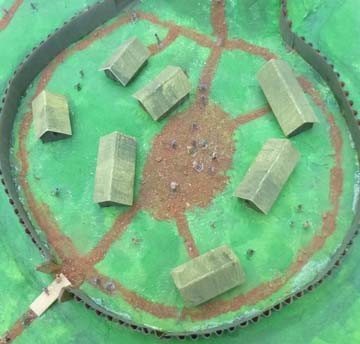The town in the bailey
In a Medieval town the houses had a thatched roof and were made of a wooden frame, with the gaps filled with woven strips of wood, known as 'wattle', and covered with clay and horse-dung.
Medieval shops were open to the street for customers, with the craftsman's house above. Because few people could read, shops signs were a huge model showing the craftsman's trade. People of the same trade often worked in the same street.
The streets of a medieval town were narrow and busy. They were noisy, with the church bells ringing and traders calling out for customers. There were many fast food sellers, selling such things as hot sheep's feet and beef-ribs.
Nobody was supposed to carry a weapon or wear a mask.
At dusk a bell rang for curfew when everyone was supposed to shut up their house, the town gates would close and a watch would patrol the streets looking for thieves or any other people who had stayed out late.
Criminals were put in the stocks or the pillory. These were wooden boards with holes for feet, hands or head, and then rotten fruit, vegetables or even stones were thrown at them. Sometimes the tops of the criminal's ears would be nailed to the board so when they were taken out the tops of their ears would be ripped off. Medieval punishments were cruel, and hanging punished crimes such as theft.
In November the poor of the town would elect a 'lord of misrule', who would wear a paper crown and get up to mischief. At Christmas poor people would go round town demanding traders to give them charity.

model of a Norman motte and bailey castle